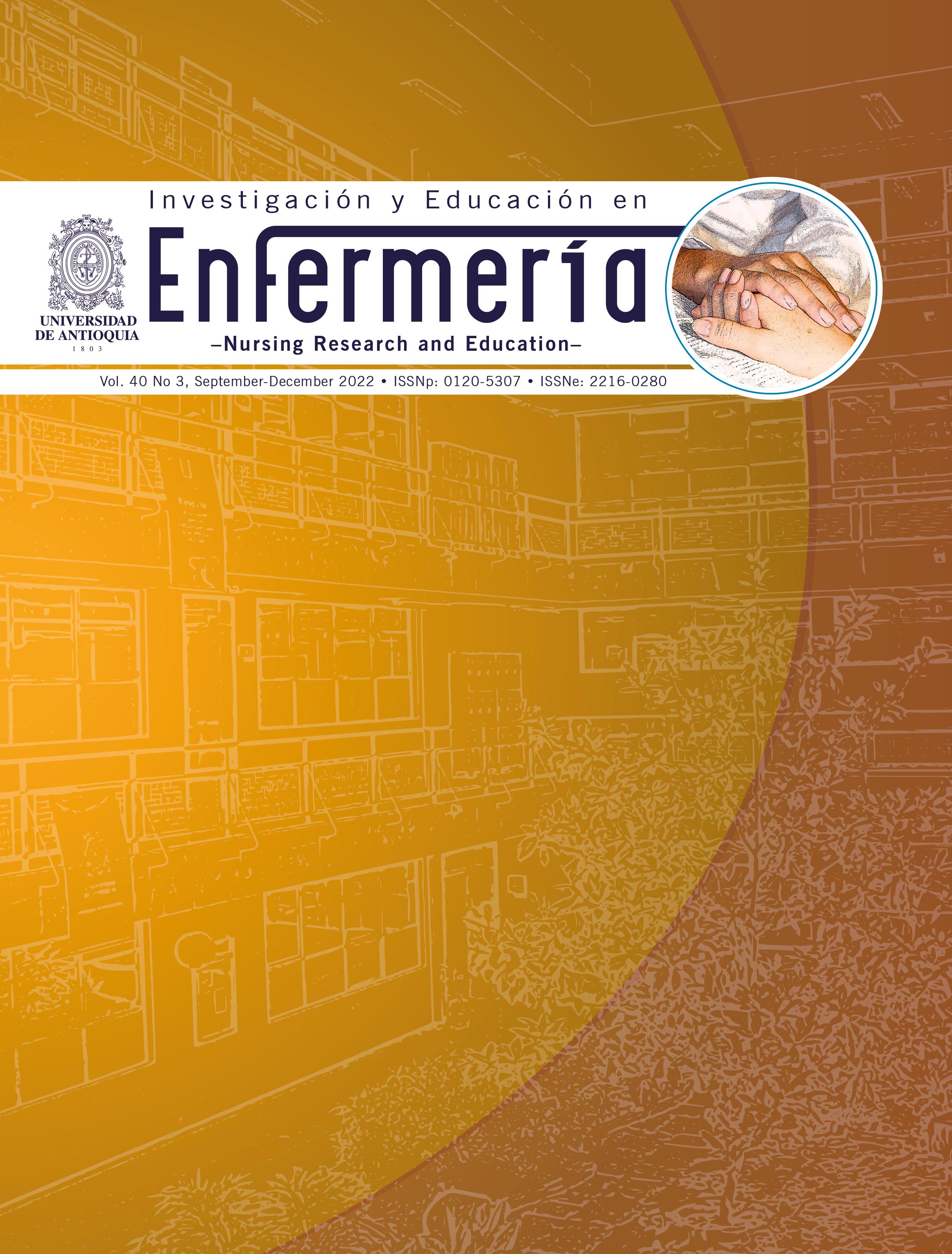Reflections on nursing students’ fear and anxiety arising from clinical practicums
DOI:
https://doi.org/10.17533/udea.iee.v40n3e13.Keywords:
Anxiety, Fear, Nursing, Nursing Education, Students, NursingAbstract
Background. Anxiety and fear are emotional responses that may emerge when individuals anticipate threats. Undergraduate nursing students may experience feelings of hopelessness and anguish in the clinical learning experience, directly impacting their academic performance. This study aims to reflect upon the fear and anxiety faced by nursing students during clinical training.
Synopsis of Contents. Two thematic axes were focused: Students’ perception regarding preceptorship attitudes and positions; Relational teaching-learning processes and their influence on the students’ professional identity. Preceptors are expected to encourage the establishment and maintenance of good relationships in the collaborative network in which students are included, especially with the multi-professional health team, to have more comprehensive academic support.
Conclusion. The role and importance of each individual in academic training, such as students and professors, is emphasized, seeking to promote positive experiences in the teaching-learning process to enable undergraduate students to more effectively develop moral sensitivity and take responsibility for patient-centered care.
Downloads
References
1. Dattani S, Ritchie H, Roser M. “Mental Health” [Internet]. Our World in Data [Internet]; 2021. Available from: https://ourworldindata.org/mental-health
2. McNaughton, N. Brain maps of fear and anxiety. Nat. Hum. Behav. 2019; 3:662-3.
3. Penninx BW, Pine DS, Holmes EA, Reif A. Anxiety disorders. Lancet. 2021; 397(10277):914-27.
4. Balogun AG, Balogun SK, Onyencho CV. Test anxiety and academic performance among undergraduates: the moderating role of achievement motivation. Span. J .Psychol. 2017; 20(E14).
5. England BJ, Brigati JR, Schussler EE. Student anxiety in introductory biology classrooms: Perceptions about active learning and persistence in the major. PLoS One. 2017; 12(8):e0182506.
6. Shapiro AL. Test anxiety among nursing students: A systematic review. Teach. Learn. Nurs. 2014; 9(4):193-202.
7. Cowen KJ, Hubbard LJ, Hancock DC. Concerns of nursing students beginning clinical courses: A descriptive study. Nurse Educ. Today. 2016; 43:64-8.
8. Savitsky B, Findling Y, Ereli A, Hendel T. Anxiety and coping strategies among nursing students during the covid-19 pandemic. Nurse Educ. Pract. 2020; 46:102809.
9. Sun FK, Long A, Tseng YS, Huang HM, You JH, Chiang CY. Undergraduate student nurses' lived experiences of anxiety during their first clinical practicum: A phenomenological study. Nurse Educ. Today. 2016; 37:21-6.
10. Wang AH, Lee CT, Espin S. Undergraduate nursing students' experiences of anxiety-producing situations in clinical practicums: A descriptive survey study. Nurse Educ. Today. 2019; 76:103-8.
11. Rigobello JL, Bernardes A, Moura AA, Zanetti ACB, Spiri WC, Gabriel CS. Supervised Curricular Internship and the development of management skills: a perception of graduates, undergraduates, and professors. Esc. Anna Nery. 2018; 22(2):e20170298.
12. Hallin K, Danielson E. Being a personal preceptor for nursing students: Registered nurses’ experiences before and after introduction of a preceptor model. J. Adv. Nurs. 2009; 65(1):161-74.
13. Escolar-Chua RL. Moral sensitivity, moral distress, and moral courage among baccalaureate Filipino nursing students. Nurs. Ethics. 2018; 25(4):458-69.
14. Rest JR. A psychologist looks at the teaching of ethics. The Hastings Center Report. 1982; 12(1):29-36.
15.Kraaijeveld MI, Schilderman J, Leeuwen E. Moral sensitivity revisited. Nurs. Ethics. 2021; 28(2):179-89.
16. Nejadsarvari N, Abbasi M, Borhani F, Ebrahimi A, Rasooli H, Motamedi MHK, et al. Relationship of moral
sensitivity and distress among physicians. Trauma Mon. 2015; 20(2):e26075.
17. Chua RLE, Magpantay JCJ. Moral distress of undergraduate nursing students in community health nursing.
Nurs. Ethics. 2019; 26(7-8):2340-50.
18. O'Mara L, McDonald J, Gillespie M, Brown H, Miles L. Challenging clinical learning environments: Experiences
of undergraduate nursing students. Nurse Educ. Pract. 2014; 14(2):208-13.
19. Cachia M, Lynam S, Stock R. Academic success: Is it just about the grades? High. Educ. Pedagog. 2018; 3(1):434-9.
20. Altiok HÖ, Üstün B. The stress sources of nursing students. Educational Sciences: TheoryPract. 2013; 13(2):760-6.
21. Bresolin JZ, Dalmolin GL, Vasconcellos SJL, Barlem ELD, Andolhe R, Magnago TSBS. Depressive symptoms among healthcare undergraduate students. Rev. Lat. Am. Enfermagem. 2020; 28:e3239.
22. Festinger L. A theory of social comparison processes. Human Relations. 1954; 7(2):117-40.
23. Pulford BD, Woodward B, Taylor E. Do social comparisons in academic settings relate to gender and academic self-confidence? Soc. Psychol. Educ. 2018; 21:677-90.
24. World Health Organization. State of the world’s nursing 2020: investing in education, jobs and leadership [Internet]. Geneva: WHO; 2020. Available from: https://www.who.int/publications-detail/nursing-report-2020
25. Mendes IAC, Trevizan MA. In the absence of light, the Nursing Now lighthouse illuminates the future. Rev. Lat.
Am. Enfermagem. 2020; 28:e3356.
Published
Versions
- 2024-10-09 (3)
- 2023-09-20 (2)
- 2022-11-12 (1)
How to Cite
Issue
Section
License
Copyright (c) 2022 Investigación y Educación en Enfermería

This work is licensed under a Creative Commons Attribution-NonCommercial-ShareAlike 4.0 International License.
Derechos de propiedad / Direitos de Propriedade
English: If the article is accepted for publication, all copyright will be of exclusive property of Investigación y Educación en Enfermería. The text and the graphics included in the publication are exclusive responsibility of the authors and not necessarily reflect the thought of the Editorial Committee.
Español: Si el artículo es aprobado para publicación, todos los derechos son de propiedad de Investigación y Educación en Enfermería. El texto y las gráficas incluidas en la publicación son de exclusiva responsabilidad de los autores y no necesariamente refleja el pensamiento del Comité Editorial.
Português: Se o artigo for aceito para publicação, todos os direitos autorais serão de propriedade exclusiva de Investigación y Educación en Enfermería. O texto e os gráficos incluídos na publicação são de responsabilidade exclusiva dos autores e não refletem necessariamente o pensamento do Comitê Editorial.















